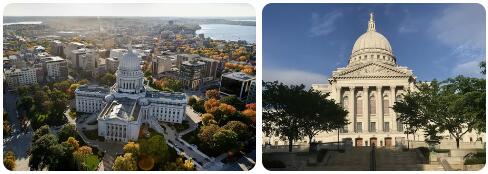Introduction
Wisconsin (abbr.: WI or Wisc.), state of the United States of America, 145,438 km2 (excl. share of the Great Lakes), with 4.8 million inhabitants; capital city: Madison.
Physical Geography
Wisconsin is predominantly a gently undulating landscape, clearly showing the hallmarks of the Pleistocene ice cover. The older subsoil is covered by thick packs of glacial deposits, coupled with a weakly undulating relief and the presence of many lakes. The lowest part of the state is along the coast of Lake Michigan (177 m), the highest point is Timms Hill (595 m). In Lake Superior the Apostle Islands belong to Wisconsin, in Lake Michigan the islands around Green Bay, such as Washington Island, Chambers Island. Despite its location on Lake Superior and Lake Michigan, only a small portion of the state drains into the lakes. In the north, the Montreal flows into Lake Superior, in the northeast flows the Menominee, Peshtigo, Oconto and the Fox river (which connects the largest lake, Lake Winnebago,
Virtually the entire state drains into the Mississippi; the state’s main river is the Wisconsin. To the west, the Trempealeau, Chippewa, and Black are direct tributaries of the Mississippi. In addition to portions of the Great Lakes, there are more than 8,000 other lakes within state borders, the largest of which is Lake Winnebago (555 km2). Wisconsin has a distinct continental climate; the influence of the great lakes tempers the extreme temperatures, but to a small extent. The average January and July temperatures are resp. –6 °C and 21 °C, the maxima and minima respectively. 40 °C and –31 °C. Precipitation averages 800 mm with a clear summer maximum. Winter precipitation falls in the form of snow. The country is covered with snow for more than 90 days of the year in the north, and about 45 days in the south. The north has only 120 frost-free days, to the south this increases to 180 days. The ports on Lake Superior and Green Bay are frozen from mid-December to early April.
Population
The average population density is 29 inhabitants. per km2. About 66% of the population lives in urban areas. The largest cities are Milwaukee and Madison.
Economy
Despite continuing industrialization and the closure of many farms, agriculture is still an important economic activity. The state is primarily an important dairy and meat producer (more than half of the companies specialize in this); also important fur products and production of honey. The main arable crops are maize, hay, wheat, barley, potatoes, soybeans, tobacco and cranberries. The state has a lot of heavy industry, especially in Milwaukee and the surrounding area. The main industrial product groups are non-electrical machines, foodstuffs, metal products, electrical machines and transport equipment. The production and processing of wood (eg paper) are important; 42% of the state is covered with forest. Wisconsin is a major energy producer; there are 152 power stations (of which 87 are hydroelectric) with a total installed capacity of 10.6 million kW. The main mining products are sand, rock, gravel, lime and taconite. Also copper, gold and silver. Tourism is the third most important economic sector.
Sights
Attractions include the various state parks (First Capitol, Kettle Moraine, Lost Dauphin), the zoo in Milwaukee, the Apostle Islands in Lake Upper, ancient Native American settlements and the 1843 Villa Louis near Prairie du Chien. Near Spring Green is Taliesin East, the home of architect Frank Lloyd Wright. The state has several winter sports areas.
History
The French invaded the area in the 17th and 18th centuries and built the fur trade on it. In 1763 the area became British. Wisconsin officially passed into American hands in 1783, but it wasn’t until the War of 1812 that the British left. Wisconsin became a territory in 1836 and a state in 1848. The state thrived on high immigration from Scandinavia and played an important part in the northern war effort in the American Civil War. After that, Wisconsin developed into a very progressive state. In the early 20th century, the state came to prominence through the progressive administration of Governor Robert La-Follette, who achieved national fame as leader of the Progressives. Recently (1993), the state suffered greatly from the flooding of the Mississippi and other rivers in the Midwest.
